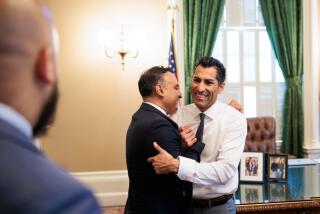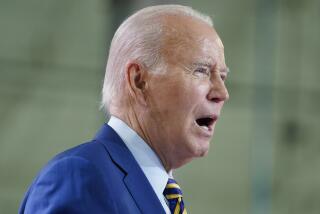Healthcare bill unveiled in House
- Share via
WASHINGTON — Senior House Democrats on Friday introduced their plan for reshaping the nation’s healthcare system, calling for a new government insurance option, a new mandate on employers to provide coverage and a new guarantee of subsidized healthcare for the poor.
The draft -- the fullest presentation so far of congressional liberals’ vision for overhauling medical care -- offered few indications of how such a plan would be financed. The price tag is expected to top $1 trillion.
The bill’s authors said they would detail their plan to cover the costs in coming weeks.
“We’re going to pay for this bill,” said House Energy and Commerce Committee Chairman Henry A. Waxman (D-Beverly Hills).
Options under consideration include cuts in Medicare and Medicaid as well as new taxes -- including the possibility of taxing some employees for job-based insurance.
The blueprint drew swift praise from President Obama. “This proposal would improve the affordability, availability and quality of healthcare and represents a major step toward . . . our goal of fixing what is broken about healthcare while building on what works,” he said in a statement.
But representatives of the insurance industry immediately attacked the proposal to offer a government medical plan that consumers could choose as an alternative to private coverage.
The industry says any such government option would have advantages that private companies could not compete with.
“While the discussion draft addresses many of the critical steps needed to transform our healthcare system, these important reforms are overshadowed by the proposed creation of a government-run health plan that would jeopardize the coverage of the 160 million people who receive their benefits through their employers today,” said Scott P. Serota, president of the Blue Cross and Blue Shield Assn.
On the other side of the Capitol, some senior Senate Democrats had already begun backing away from the so-called government option, seeing it as an obstacle in terms of cost and building bipartisan support.
When Sens. Edward M. Kennedy (D-Mass.) and Christopher J. Dodd (D-Conn.) recently introduced their version of healthcare reform, they did not include the government-option provision.
Under the House bill unveiled Friday, the government’s insurance program would offer consumers a benefit package including preventive health services, mental health services, dental and vision care for children and annual caps on the amount of money subscribers would have to pay.
“Choice is the key,” Waxman said. “Choice is the key for consumers to pick which plan they want, whether it’s a private insurance plan or a public insurance plan.”
The bill envisions that Americans earning up to 400% of the federal poverty level -- or $88,000 for a family of four -- could qualify for credits to help them buy insurance. It would also provide new federal dollars to open up the Medicaid program to Americans earning up to 133% of the federal poverty level and raise reimbursement levels for doctors and hospitals participating in the program. Currently, Medicaid, which is administered by state governments, is often limited to poor families and, in some states, pays providers so little that many refuse to give care.
Nearly all Americans would be required to get insurance.
For doctors, the House lawmakers pledged an end to the annual threat of dramatic cuts in Medicare reimbursement rates. And for seniors, the bill would close the so-called doughnut hole in Medicare Part D drug benefits that socks many with high bills for prescription medications.
But the proposal for a new public insurance program, which Waxman said could initially pay Medicare rates, will almost certainly generate opposition from physician groups. Drug makers, whom Waxman and other Democrats accused of reaping windfalls from the government’s drug purchasing, may become another obstacle.
And business leaders are already fighting proposals being discussed in the Senate to mandate that employers provide coverage or pay a fee to the government. The draft House legislation puts that fee at 8% of payroll, though senior Democrats said that could change as the legislation is debated.
In the Senate, Democrats spent much of last week trying to hold together the consensus behind the healthcare push. Outside Washington, the political battle is also intensifying, as liberal political groups step up their efforts to pressure congressional Democrats not to back away from plans to create a new government insurance program.
The grass-roots powerhouse MoveOn.org began airing a radio ad targeting Sen. Mary L. Landrieu of Louisiana, a moderate Democrat who has expressed reservations about a new so-called public plan.
And Health Care for America Now, which has been helping lead the charge for a public plan, began airing a television ad in 10 states that casts the proposal as a way to give consumers more choice in selecting health insurance.
Critics of a government insurance program say it could drive private insurers out of business, leaving consumers with less choice.
--
More to Read
Get the L.A. Times Politics newsletter
Deeply reported insights into legislation, politics and policy from Sacramento, Washington and beyond. In your inbox twice per week.
You may occasionally receive promotional content from the Los Angeles Times.











